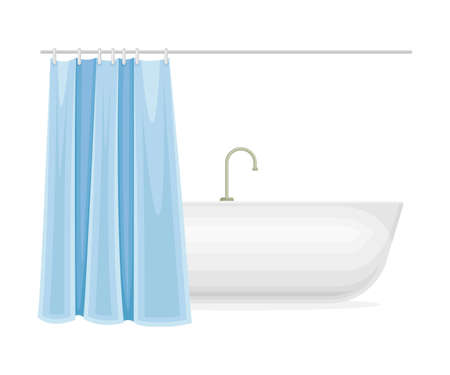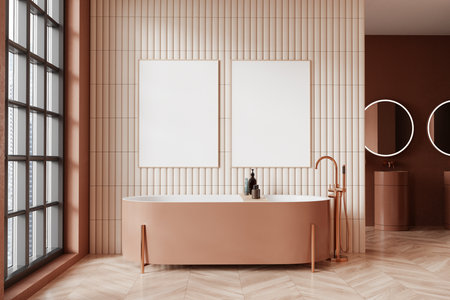Introduction to Bathroom Flooring
Choosing the right flooring for your bathroom is more important than you might think. Bathrooms are unique spaces in American homes because they face constant moisture, heavy foot traffic, and changing style trends. The floor you pick not only affects how your bathroom looks, but also how it holds up over time and fits within your budget.
Why Flooring Choice Matters in Bathrooms
Bathrooms are exposed to water from showers, sinks, and toilets on a daily basis. This means that some flooring materials can warp, stain, or become slippery if they’re not designed for wet environments. In addition, bathrooms are often high-traffic areas, especially in busy households, so durability is key. Last but not least, with open floor plans and spa-like designs gaining popularity in the U.S., homeowners want a bathroom floor that matches their personal taste and enhances their home’s value.
Common Challenges with Bathroom Flooring
| Challenge | Description |
|---|---|
| Moisture & Humidity | Can cause damage like warping, mold, or mildew if flooring is not waterproof or water-resistant. |
| Foot Traffic | Floors need to withstand daily use without showing excessive wear or becoming unsafe. |
| Style Trends | Homeowners look for floors that fit modern or classic design preferences and add to resale value. |
Key Considerations Before Choosing Your Bathroom Floor
- Water Resistance: Essential for any bathroom floor to prevent damage and safety hazards.
- Durability: Choose a material that stands up to regular cleaning and use.
- Cost: Balance between upfront price and long-term maintenance expenses.
- Aesthetics: Make sure your choice complements the rest of your home’s style.
Selecting the right bathroom flooring involves understanding these challenges and knowing what features matter most for your household. In the next sections, we’ll compare popular options based on durability, cost, and aesthetics to help you make an informed decision.
2. Popular Bathroom Flooring Materials
When it comes to choosing bathroom flooring in the U.S., homeowners have a variety of options that balance style, durability, and budget. Each material has its own unique advantages and reflects the preferences and lifestyle trends popular across America. Let’s take a closer look at the top choices:
Ceramic Tile
Ceramic tile is one of the most common bathroom flooring options in American homes. Known for its water resistance, easy maintenance, and classic appeal, ceramic tile fits both modern and traditional designs. It’s available in countless colors, patterns, and sizes.
Why It’s Popular
Ceramic tiles are budget-friendly and widely available at home improvement stores. Many U.S. homeowners appreciate how simple it is to clean and replace damaged tiles if needed.
Porcelain Tile
Porcelain tile is similar to ceramic but denser and less porous, making it even more water-resistant—perfect for busy family bathrooms. Porcelain often mimics natural stone or wood looks while being easier to maintain.
Why It’s Popular
Americans love porcelain tile for its upscale appearance and toughness. It stands up well to heavy foot traffic, kids, and pets—common factors in many U.S. households.
Luxury Vinyl
Luxury vinyl planks (LVP) or tiles (LVT) have surged in popularity thanks to their affordability, comfort underfoot, and impressive ability to replicate high-end materials like wood or stone. It’s also waterproof and DIY-friendly.
Why It’s Popular
Many American families choose luxury vinyl for its warm feel, slip-resistance, and wide range of styles that fit both classic and contemporary tastes.
Natural Stone
Materials like marble, slate, travertine, or granite offer a timeless, elegant look. Stone floors make a statement in luxury bathrooms and are highly valued in real estate markets across the U.S.
Why It’s Popular
Natural stone appeals to those who want a unique, high-end finish. While more expensive and requiring regular sealing, it adds value to homes—something many American homeowners consider when remodeling.
Engineered Wood
Engineered wood brings the warmth of real hardwood into spaces where solid wood isn’t recommended due to moisture. With a top layer of real wood over plywood or fiberboard core, it handles humidity better than traditional hardwoods.
Why It’s Popular
This option attracts those seeking the cozy look of wood with improved moisture resistance—a growing trend as Americans blend spa-like features with homey touches in their bathrooms.
Quick Comparison Table
| Material | Durability | Cost Range (per sq ft) | Aesthetic Appeal | Cultural Popularity in U.S. |
|---|---|---|---|---|
| Ceramic Tile | High | $1–$5 | Classic; versatile colors/patterns | Very popular; widely used |
| Porcelain Tile | Very High | $2–$8 | Sleek; can mimic stone/wood | Increasingly popular for upscale looks |
| Luxury Vinyl (LVP/LVT) | High | $2–$7 | Mimics wood/stone; warm feel | Rapidly gaining popularity nationwide |
| Natural Stone | Very High (with maintenance) | $6–$20+ | Luxe; unique patterns/colors | Loved for luxury remodels & resale value |
| Engineered Wood | Moderate-High | $4–$10 | Warm; authentic wood look | A trendy choice for spa-like bathrooms |
This overview highlights how each flooring material meets different needs and design goals for American bathrooms—from budget-friendly ceramic to high-end natural stone.

3. Durability and Maintenance Considerations
How Different Bathroom Flooring Materials Stand Up to Daily Life
When choosing bathroom flooring, it’s essential to think about how well different materials can handle water, humidity, and everyday wear and tear. Bathrooms are high-traffic, moisture-prone spaces, so your flooring needs to be both tough and easy to care for. Here’s a simple comparison of the most popular bathroom flooring options in the U.S.
| Material | Water Resistance | Humidity Tolerance | Scratch & Dent Resistance | Maintenance Needs |
|---|---|---|---|---|
| Ceramic or Porcelain Tile | Excellent – virtually waterproof when properly installed | High – unaffected by steamy conditions | Very good – hard surface resists most damage | Sweep/mop regularly; reseal grout occasionally |
| Vinyl (Sheet or Luxury Vinyl Plank) | Excellent – water cannot penetrate surface | High – handles humidity well with no warping | Good – softer than tile but resists most scratches/dents | Sweep/mop as needed; low maintenance overall |
| Natural Stone (Marble, Slate, Granite) | Good – depends on type and proper sealing | Moderate to High – some stones more porous than others | Varies – marble is softer; granite is very durable | Sweep/mop regularly; reseal every 1-2 years |
| Laminated Flooring | Poor to Moderate – not recommended unless labeled “water-resistant” or “waterproof” laminate is used | Poor to Moderate – can swell or warp with excess moisture | Moderate – can scratch, especially if not high quality | Sweep/vacuum; avoid standing water; replace damaged planks promptly |
| Bamboo or Engineered Wood | Poor to Moderate – sensitive to standing water unless specifically designed for bathrooms | Poor to Moderate – may warp in high humidity without special treatment | Moderate – can dent or scratch under heavy use | Sweep/vacuum; wipe spills quickly; periodic refinishing/sealing recommended |
| Cork Flooring (Sealed) | Moderate – must be properly sealed against water intrusion | Moderate – generally okay if kept dry on the surface | Softer surface – can dent from heavy objects or heels | Sweep regularly; reseal annually; avoid prolonged standing water |
Practical Tips for Long-Lasting Bathroom Floors
- Avoid carpet: While cozy, carpet traps moisture and is not suitable for bathrooms due to mold and mildew risks.
- Choose waterproof options: Ceramic/porcelain tile and vinyl are top choices for busy family bathrooms where spills and splashes happen often.
- Seal natural materials: If you love the look of stone or wood, make sure they’re properly sealed to prevent damage from water and humidity.
Caring for Your Bathroom Floor Made Simple
No matter which material you choose, regular sweeping and mopping help keep your floor looking great. Always follow manufacturer care instructions—especially when using cleaners—to protect finishes and warranties. For grout lines or porous surfaces, resealing every year or two is a smart move for long-term durability.
Main Takeaway on Durability & Maintenance:
Ceramic/porcelain tiles and vinyl floors offer the best mix of durability and low maintenance for most American bathrooms. Natural stone adds luxury but requires extra care. Laminate, bamboo, and cork need special attention to avoid water damage. Picking the right flooring will make daily life easier while keeping your bathroom stylish for years to come.
4. Cost Comparison
Upfront Installation Costs for Popular Bathroom Flooring Options
When planning your bathroom remodel, understanding the costs involved is key to making a smart choice. Let’s break down the average upfront installation costs of popular bathroom flooring types in the U.S., so you can plan your budget with confidence.
| Flooring Type | Average Material Cost (per sq. ft.) | Installation Cost (per sq. ft.) | Total Average Cost (per sq. ft.) |
|---|---|---|---|
| Ceramic or Porcelain Tile | $1 – $10 | $5 – $10 | $6 – $20 |
| Vinyl (Sheet, Plank, or Tile) | $1 – $5 | $2 – $5 | $3 – $10 |
| Natural Stone (Marble, Slate, etc.) | $5 – $25+ | $7 – $15+ | $12 – $40+ |
| Engineered Wood or Laminate* | $2 – $8 | $2 – $8 | $4 – $16 |
| Bamboo Flooring* | $3 – $8 | $4 – $8 | $7 – $16 |
| Cork Flooring* | $3 – $8 | $5 – $10 | $8 – $18 |
| Concrete | $2 – $6 | $4 – $8 | $6 – $14 |
| *Note: Not all wood, bamboo, or cork floors are recommended for high-moisture bathrooms. Choose only waterproof or water-resistant versions. | |||
Long-Term Value and Maintenance Costs
While some flooring types may seem expensive upfront, they often offer excellent long-term value due to their durability and low maintenance needs. For example, ceramic and porcelain tiles can last for decades with minimal upkeep, while natural stone may require periodic sealing but adds resale value. Vinyl is one of the most budget-friendly options for both initial cost and maintenance.
Typical Lifespan of Bathroom Flooring:
- Ceramic/Porcelain Tile: 20–50 years with proper care.
- Luxury Vinyl: 10–20 years depending on quality.
- Natural Stone: 30+ years, requires sealing every 1–2 years.
- Laminates & Engineered Wood: 10–15 years if water-resistant; less if exposed to frequent moisture.
Budgeting Tips for a Bathroom Remodel in the U.S.
- Measure accurately: Know your exact square footage to avoid overbuying materials.
- Add a buffer: Purchase an extra 10% of material for cuts and future repairs.
- DIY vs. Pro Install: DIY installation can save money on some products like vinyl planks, but professional installation is recommended for tile and stone to ensure waterproofing and longevity.
- Factor in underlayment and waterproofing: Don’t forget costs for moisture barriers or backer boards where needed.
A Sample Budget Breakdown for a 50 Sq. Ft. Bathroom Floor (U.S. Averages):
| Flooring Type | Total Material Cost (50 sq. ft.) |
Total Installed Cost (50 sq. ft.) |
|---|---|---|
| Ceramic/Porcelain Tile | $50–$500 | $300–$1,000 |
| Vinyl Plank/Tile | $50–$250 | $150–$500 |
| Natural Stone | $250–$1,250+ | $600–$2,000+ |
Selecting the right bathroom flooring means balancing what you love with what fits your budget—both now and over time. With this breakdown, you can start planning your remodel with realistic expectations!
5. Aesthetic Appeal and Design Trends
When it comes to choosing bathroom flooring, style is just as important as function. American homeowners often look for options that fit modern design trends while matching their personal taste. Here’s how popular flooring types stack up in terms of looks, colors, patterns, and textures.
Ceramic and Porcelain Tile
Design Flexibility: Tiles are a favorite in U.S. bathrooms because they come in almost every color, size, and shape imaginable. Large-format tiles are especially trendy for creating a seamless, modern feel. Subway tiles and hexagonal patterns remain classic choices.
Texture & Finish: Matte finishes and textured surfaces are gaining popularity for their slip resistance and sophisticated look.
Luxury Vinyl Plank (LVP) and Tile (LVT)
On-Trend Styles: LVP and LVT mimic the appearance of hardwood or stone but offer more waterproofing—perfect for busy American families. Gray-washed wood planks and herringbone patterns are particularly popular right now.
Color Choices: Cool tones like greige (gray + beige), coastal blues, and natural wood shades are common picks for a spa-like atmosphere.
Natural Stone
Timeless Appeal: Marble, slate, and travertine bring luxury to any space. While marble veining is always in style, bolder patterns and darker stones are emerging as contemporary favorites among upscale homes.
Texture: Honed or tumbled finishes create a soft, matte look that feels both elegant and welcoming.
Laminates
Visual Variety: Laminate has improved dramatically and can now convincingly resemble wood or tile. It’s used in powder rooms or half-baths where high moisture isn’t an issue.
Trendy Looks: Light oak and distressed barnwood visuals suit farmhouse-inspired bathrooms—a top trend in many American homes.
Comparison Table: Bathroom Flooring Aesthetics
| Flooring Type | Popular Colors/Patterns | Main Texture/Finish | Fits Which Design Style? |
|---|---|---|---|
| Ceramic/Porcelain Tile | White, gray, bold colors; subway, hexagon, large format | Satin, matte, textured | Modern, transitional, classic |
| LVP/LVT | Gray-wash, greige, herringbone; wood-look | Smooth, hand-scraped | Spa-inspired, contemporary, rustic |
| Natural Stone | Bolder veining, dark hues; marble slab looks | Honed, tumbled | Luxury, timeless elegance |
| Laminates | Pale oak, barnwood effects; plank layouts | Smooth to lightly textured | Farmhouse, casual modern |
Current U.S. Bathroom Flooring Trends at a Glance:
- Larger tiles: Fewer grout lines for a clean look.
- Naturally inspired colors: Soft neutrals like ivory, taupe, and pale gray dominate.
- Mimicry products: Flooring that imitates wood or stone gives high-end looks without the high price tag.
- Bolder accents: Statement floors with geometric patterns or mosaic inlays add character to smaller spaces.
- Sustainable choices: Eco-friendly materials are increasingly popular among environmentally conscious homeowners.
The right bathroom flooring can elevate your space visually while aligning with current American tastes—whether you prefer a sleek modern vibe or a warm rustic retreat.
6. Factors to Consider When Choosing Bathroom Flooring
When selecting the right flooring for your bathroom, it’s important to look beyond just appearance and price. Several key factors can help you make a smart and comfortable choice for your home. Here are some of the most important aspects to keep in mind:
Comfort Underfoot
Bathrooms are often used barefoot, so comfort matters. Some flooring materials, like vinyl and cork, feel warmer and softer underfoot compared to tile or stone, which can be hard and cold.
Slip Resistance
Safety is essential, especially in a space that often gets wet. Look for flooring with a textured surface or slip-resistant rating to help prevent falls—this is especially important for families with kids or seniors.
| Flooring Type | Slip Resistance |
|---|---|
| Ceramic/Porcelain Tile | Medium to High (textured options available) |
| Vinyl | Medium (choose slip-resistant types) |
| Natural Stone | Varies (textured finishes recommended) |
| Cork | Medium (naturally slip-resistant) |
| Engineered Wood/Laminate | Low (can be slippery when wet) |
Heating Compatibility
If you’re considering radiant floor heating, not all materials are equally compatible. Tile and stone conduct heat well and are great choices for heated floors. Vinyl and laminate can also work but check manufacturer recommendations first.
Eco-Friendliness
If sustainability is important to you, look into eco-friendly flooring options. Materials like bamboo, cork, and certain types of linoleum are renewable and have less environmental impact compared to traditional vinyl or non-recycled tiles.
| Flooring Type | Eco-Friendliness |
|---|---|
| Bamboo | High (fast-growing renewable resource) |
| Cork | High (harvested from bark without harming trees) |
| Ceramic/Porcelain Tile | Medium (long-lasting but energy-intensive production) |
| Vinyl | Low (petroleum-based, not biodegradable) |
| Laminates with Recycled Content | Medium (depends on recycled material percentage) |
Other Practical Tips
- Maintenance: Choose a material that fits your lifestyle—some floors need more care than others.
- Water Resistance: Make sure your flooring can handle moisture without warping or staining.
- Aesthetics: Match the flooring style to your overall bathroom design for a cohesive look.
Your Bathroom, Your Choice!
Selecting bathroom flooring isn’t just about looks; it’s about finding a balance between comfort, safety, practicality, and style that fits your family’s needs.
7. Conclusion and Recommendations
When it comes to choosing the right bathroom flooring, it’s important to balance durability, cost, and style. Here’s a quick summary of the top options American homeowners often consider, along with expert tips for different needs and budgets.
Summary Table: Bathroom Flooring Comparison
| Flooring Type | Durability | Average Cost (per sq. ft.) | Aesthetic Options | Best For |
|---|---|---|---|---|
| Ceramic/Porcelain Tile | Excellent | $2 – $10 | Wide range of colors & patterns | Most homes, high-traffic areas |
| Vinyl (Sheet, Plank, or Tile) | Very Good | $1 – $5 | Many modern styles, waterproof | Budget-friendly remodels, DIY projects |
| Natural Stone (Marble, Slate, etc.) | Excellent (with sealing) | $5 – $20+ | Luxurious, unique natural look | High-end bathrooms, resale value boost |
| Laminates (Waterproof) | Good (if water-resistant type) | $2 – $6 | Wood-look options available | Quick updates, moderate budgets |
| Engineered Wood (Water-resistant) | Moderate | $4 – $8 | Warm wood appearance | Guest baths or powder rooms with low moisture |
| Bamboo (Strand-woven) | Good (if sealed) | $4 – $8 | Sustainable and modern look | Eco-conscious homeowners, light-use spaces |
Main Takeaways for American Homeowners
- If you want long-lasting flooring: Porcelain and ceramic tiles are hard to beat in terms of durability and water resistance.
- If budget is your priority: Vinyl offers a wide selection of designs at wallet-friendly prices—and it’s easy to install yourself.
- If you love luxury: Natural stone makes a big impression but comes with higher costs and maintenance needs.
- If you want a wood look: Consider waterproof laminate or engineered wood designed for bathrooms—just be mindful of moisture exposure.
Expert Recommendations by Needs & Budgets
- For families with kids: Pick vinyl or tile for easy cleaning and strong water resistance.
- If you’re remodeling on a budget: Sheet vinyl or basic ceramic tiles are both affordable and practical.
- If resale value matters: Invest in timeless tile or stone floors to attract future buyers.
- If sustainability is important: Look for certified bamboo or recycled-content tiles that hold up well in bathroom conditions.
Your Next Steps?
No matter your style or budget, there’s a bathroom flooring option that fits your needs. Think about how much traffic your bathroom gets, how much time you want to spend on maintenance, and what kind of look feels right for your home. If you’re still unsure, consult with a local flooring expert—they’ll help match you with the best choice for your space and lifestyle.


